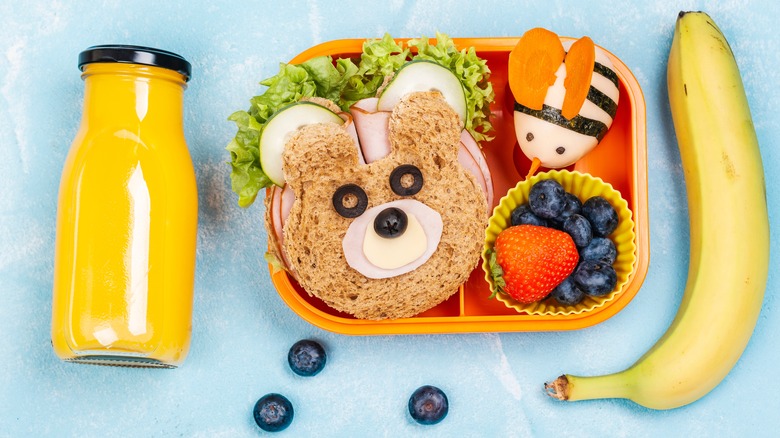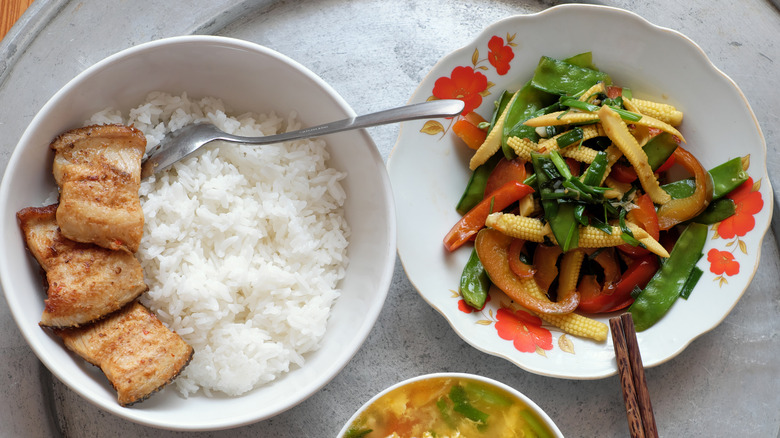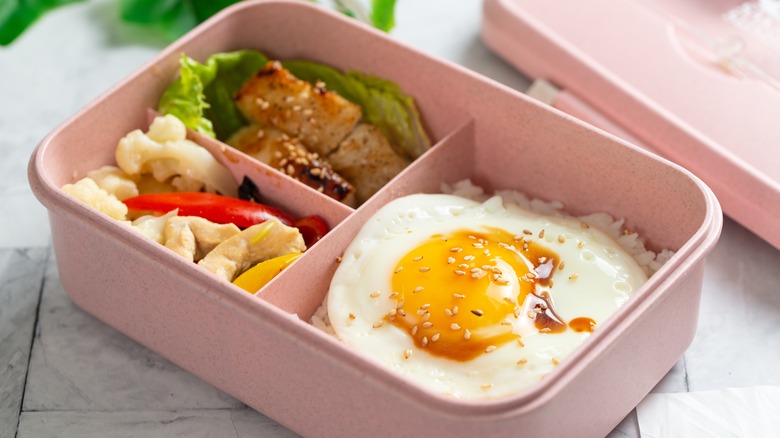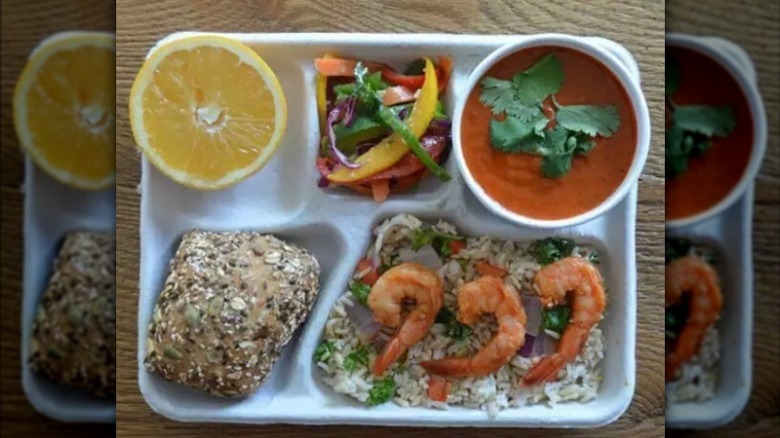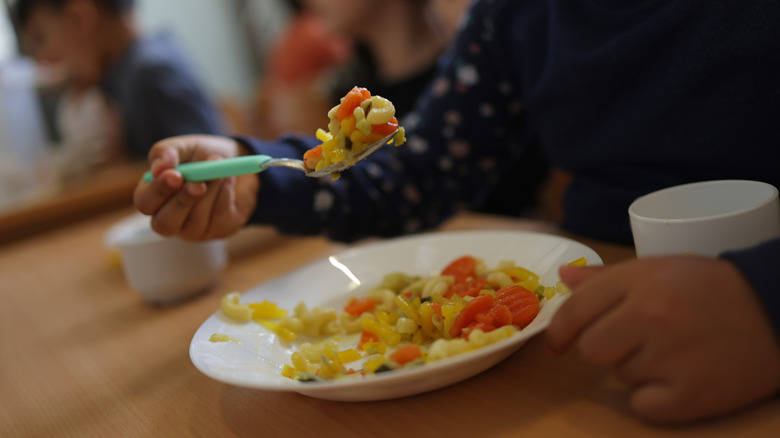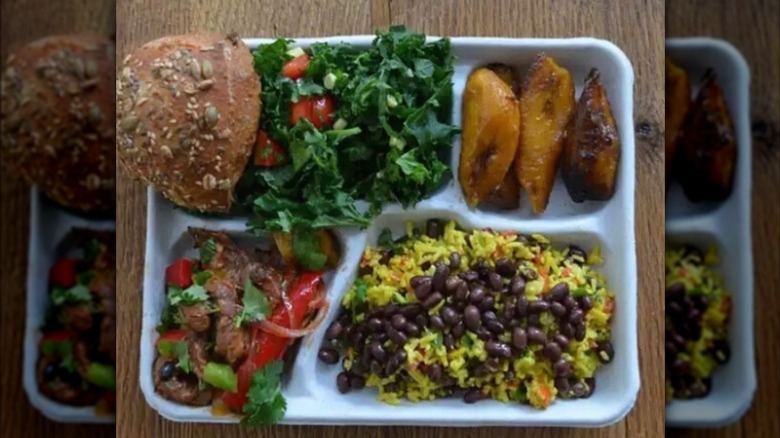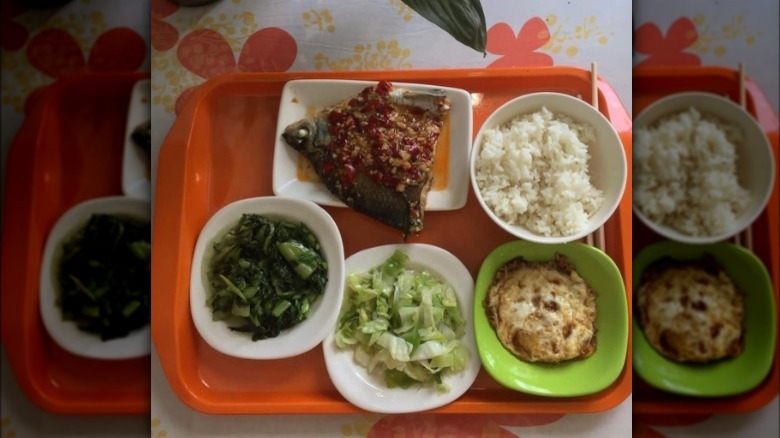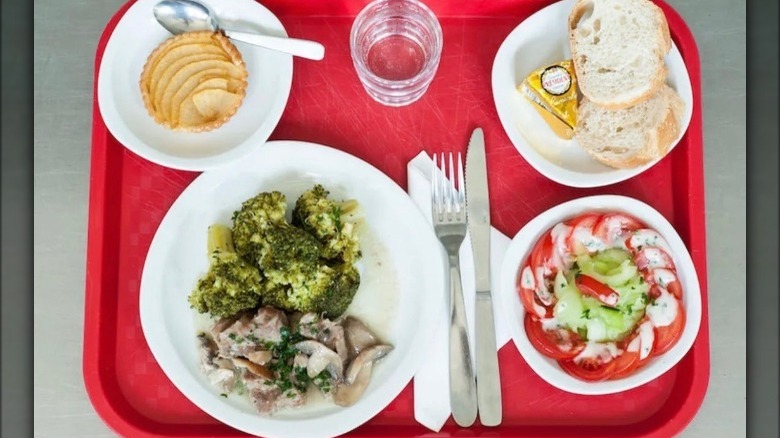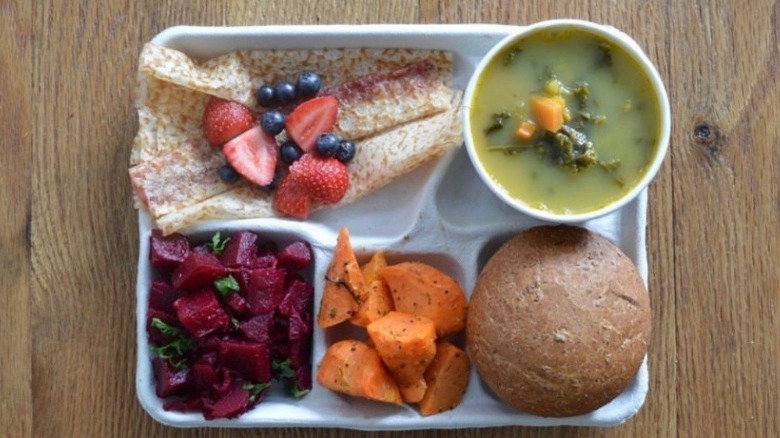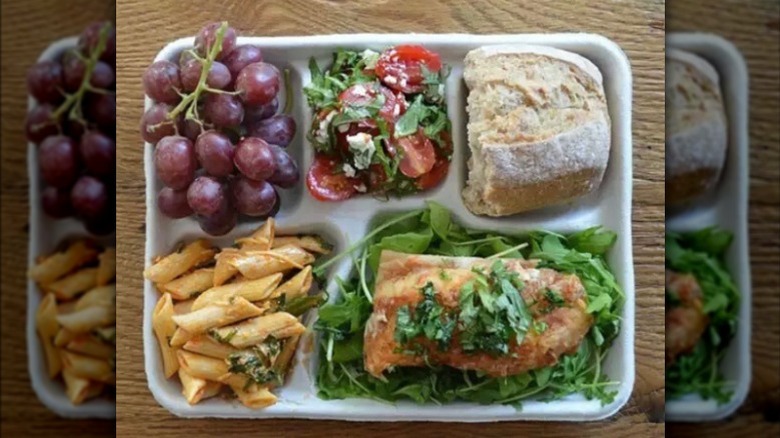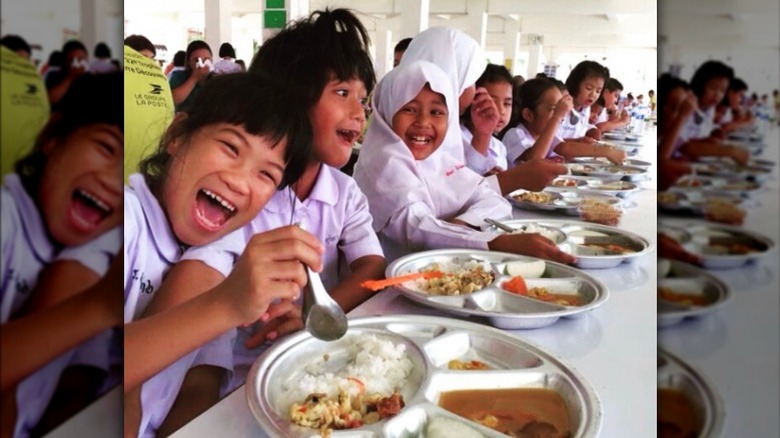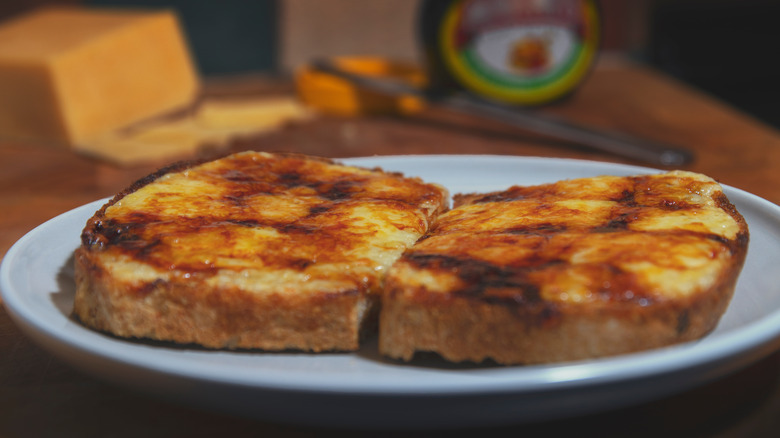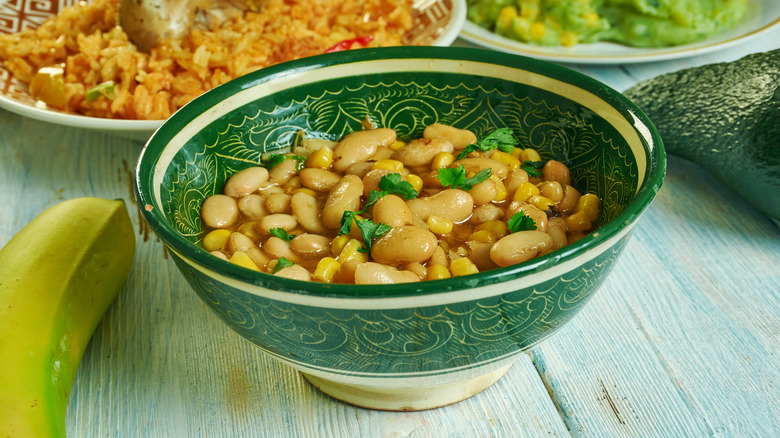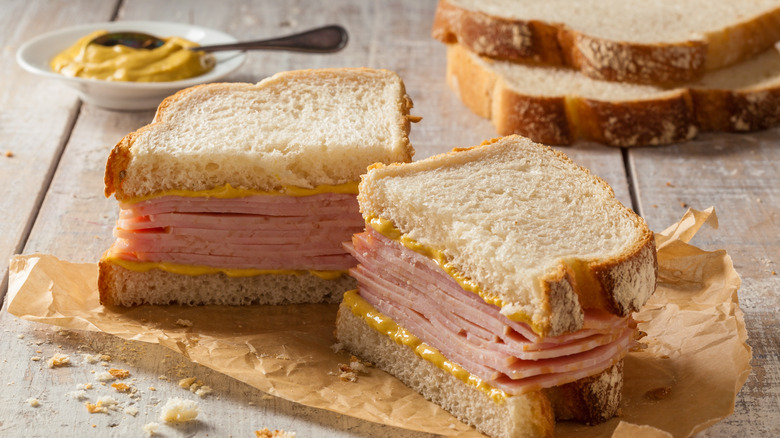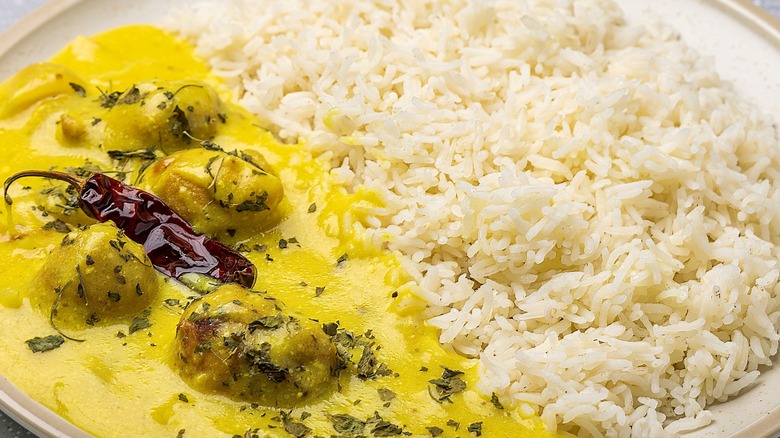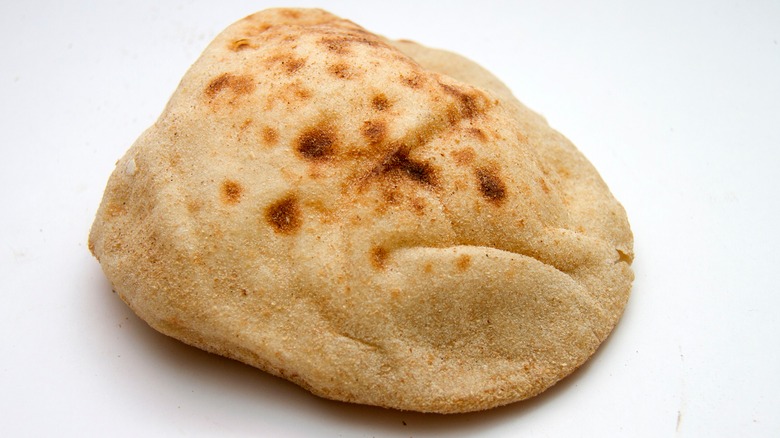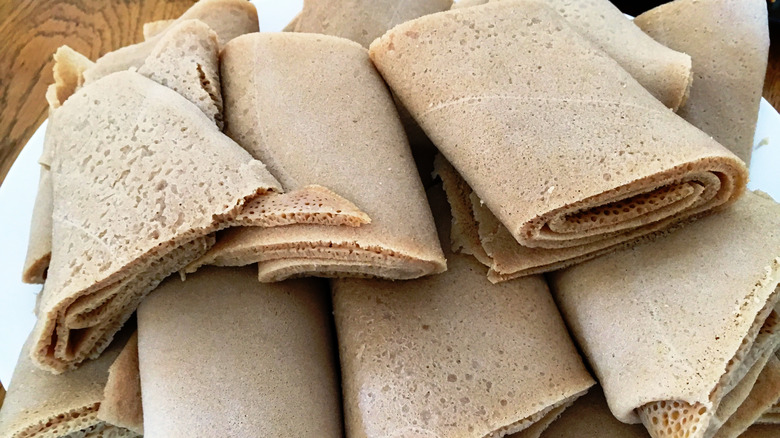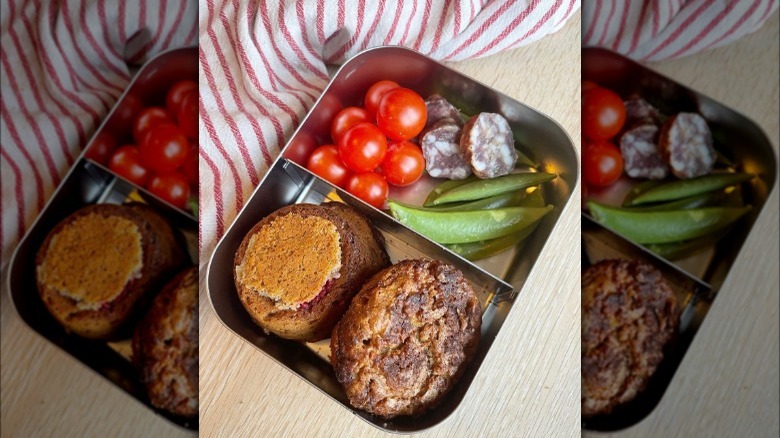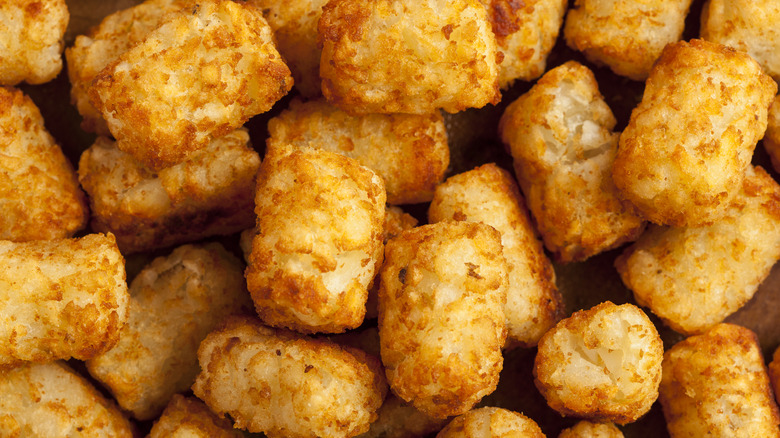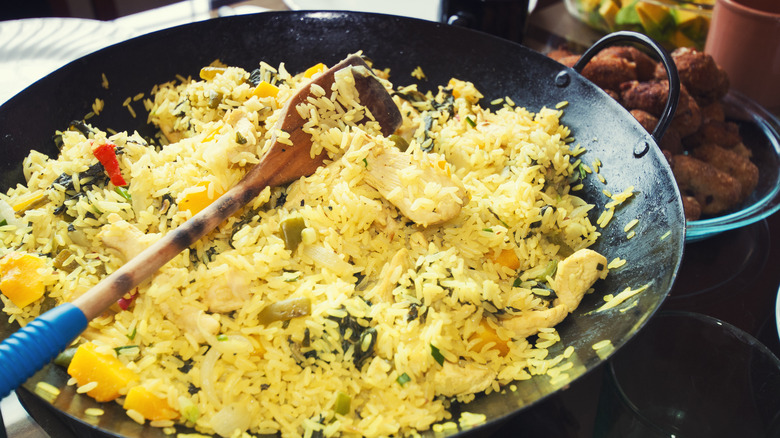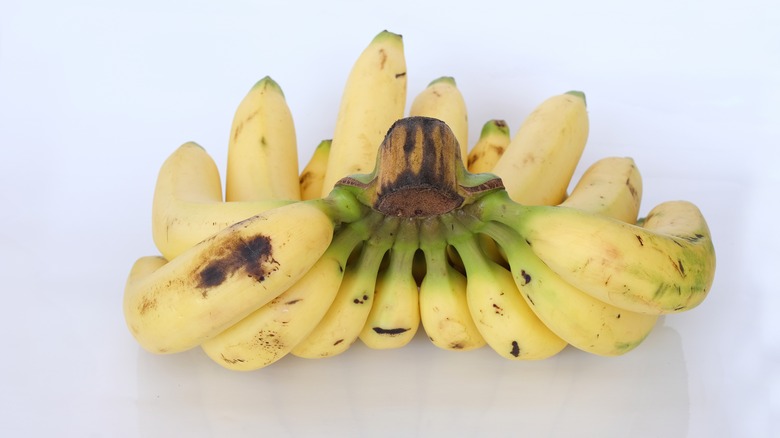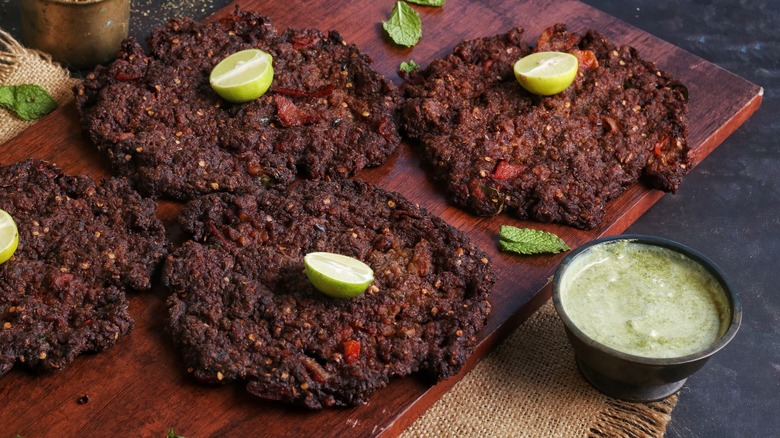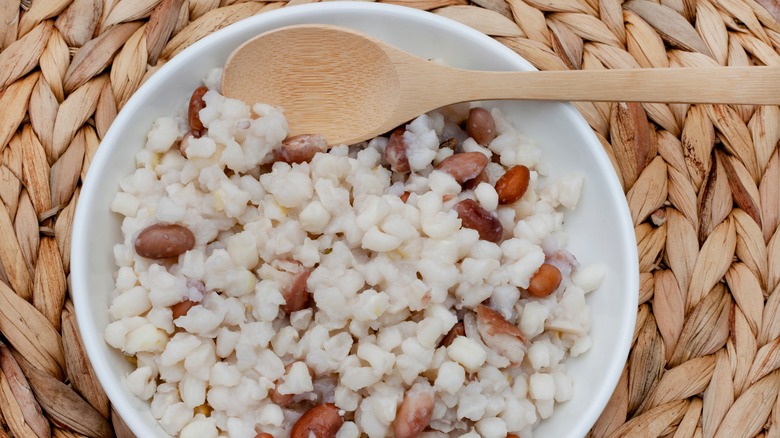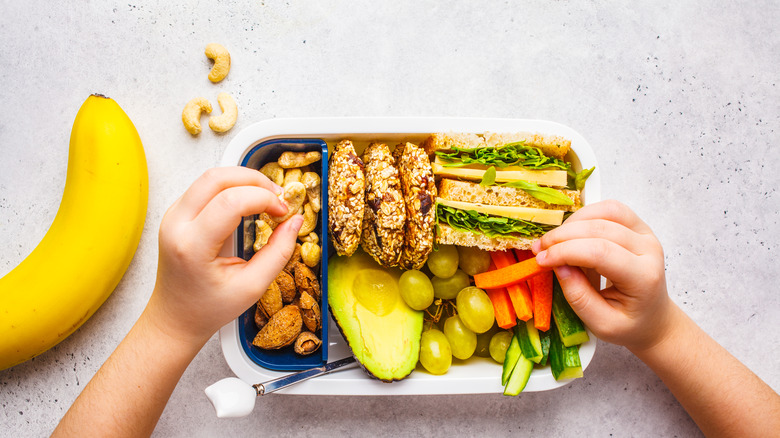What School Lunches Look Like Around The World
The concept behind school lunch — feeding kids in an institution rather than at home — originated in Germany in the 1790s; Count Rumford, an American-born man, started offering food to poor children who worked part-time to pay for food and school. These meals were rudimentary and made with relatively inexpensive ingredients like barley and potatoes. School lunches didn't catch on in America until the 20th century, with charitable institutions like the Women's Educational and Industrial Union providing food for nearly 5,500 kids daily (via Mental Floss). The meals at this time featured items like vegetable soup, marmalade sandwiches, bread, and baked beans.
Anyone who grew up in the American school system probably has not-so-fond memories of cardboard pizza, par-frozen juice, and tiny containers of chocolate milk in the lunch line. But the way we think of these standard meals in the US is very different from those around the world. Here are some of the ways other countries serve up school lunches.
Vietnam
Vietnamese school lunches are built around one key ingredient: rice. The grain is served with a filling protein like tofu, fish, chicken, or pork, dressed in a sauce like cà ri. Each meal is finished with a tráng mięng — a side dish that acts as a palate cleanser. The fruit can range from tropical produce like guava, lychee, dragon fruit, or durian (via The Takeout). The meal may also include a glass of soy milk and a traditional Vietnamese dessert called chè — a three-layer fruity dessert made with coconut milk.
Most children's lunches in Vietnam are eaten at home since most schools lack the kitchen equipment to serve food to the masses.
Japan
According to Study International, school lunches in Japan are designed by nutritionists and provided to all primary — and some junior high — school students across the country. These meals are eaten in the classroom rather than in a separate cafeteria, with lessons about nutritional eating integrated into the curriculum.
Japanese school lunches are centered around a healthy blend of proteins, carbs, fats, and milk. These foods are almost entirely made from fresh rather than frozen, processed foods. You may see plates of rice with grilled fish, cooked spinach and sprouts, miso soup with pork, and sides of soy milk served with the meal. Families may also prepare obento boxes for school-aged children filled with rice, meat, fruit, and vegetables in cute, colorful designs.
Spain
According to Meddeas, school lunch in Spain is served in a two-course family-style fashion. You may find a bowl of crema de calabaza (pumpkin cream soup) served on the table. Paella, a Spanish rice dish, is also common — it is prepared with cooked long-grain rice, carrots, peas, potatoes, and chunks of cod. OhlaLiving notes that Spanish school lunches usually contain a serving of beans or lentils, along with bread and salad. The meals are usually finished with fruits like melon, oranges, or apples served with an option of yogurt.
As a whole, the students' lunches are nutrient-rich and filling.
Germany
According to The German Way & More, lunch tends to be the largest meal of the day for Germans. SNC notes that schools allot time between 12 and 2 in the afternoon to have "mittagessen." The meal usually begins with a starter course, such as a potato salad, followed by kartoffeltaschen (stuffed potato pockets) or wurst (German sausage). There is also often a large serving of bread, like pumpernickel, rye, or white bread, served with the lunch. You may also find fresh fruit or vegetables in some students' meals.
Soups and salads are usually reserved as sides for a smaller dinner.
Brazil
According to the Pulitzer Center, Brazil's school lunch program feeds 42 million children across the country — making it the second-largest school lunch program globally. Staple components of the meals include rice, beans, meat, and salad.
Younger students can eat anywhere from three to five meals a day, all provided by the school. The country's constitution uniquely requires a minimum of 30% of the food served for school lunches to come from local farms. The World Food Program USA notes that Brazil also has many initiatives for school kitchens to minimize food waste through soups, stocks made with vegetables and meat leftovers, and rice dishes.
China
China expanded free school lunches to all students in the country in 2011 and has seen dramatic increases in the nutritional well-being of rural children (via Nikkei Asia). This program has transformed the typical midday meal from rice and soybeans to eggs, soy products, and meats like savory pork. You may also see noodles, buns, and rolls served in canteen-style trays.
Several traditional dishes have made their way onto Chinese school lunch menus, like tomato eggs — a scrambled egg dish served with spices and tomato sauce — and sides like steamed bok choi, fish and vermicelli noodles, and mandarin oranges (via YouTube).
France
School lunches in France consist of three or four courses, including salads, entrees, cheese, and desserts. You won't find many examples of "kid foods" on the menu; instead, you'll discover nutrient-rich, flavorful options like beet salad, brie cheese, salmon lasagna and steamed spinach, French shepherd's pie with beef, fruit, and small choux pastries for dessert (via Karen Le Billion).
Karen Le Billion also notes that school lunches in France are paid for through local municipalities and are often heavily subsidized; the meals cost $3 each on average. Over six million children across the country participate in the program daily.
Finland
Finland has a federally-funded school lunch program that serves close to 850,000 students each day. Children's meals feature several local recipes and staples, including a warm main course that can be made vegetarian with beans and sprouts or fish or meat. The entree is also served with a side of vegetables, which can be in the form of a salad, grated, or steamed. You'll also find bread with water and semi-skimmed milk or buttermilk to drink (via Finnish National Agency for Education).
In addition to the regular lunch, the government also supplies snacks for youth participating in before or after-school activities.
Italy
Italian school lunches are based around a starch, which can include pasta, rice, or soup, and a main course — made with meat, eggs, fish, or cheese. The plates are also filled with at least two vegetables or fruit. According to Gambero Rosso, the particularities of the lunch are determined by a rotating schedule over four weeks. At least ten of those meals must include vegetables, ten with pulses or starches, and eight with fruit. School cafeterias are not allowed to serve fried food or foods high in sodium.
Different municipalities in the country may have different standards for what options are provided. In Rome, for example, 70% of the food fed in school cafeterias is organic.
Thailand
Thai school lunches always contain rice, fruits, and vegetables, with the ratio typically being up to 33% rice, with the remainder being one or two sides (via the Cambridge University Press). According to Beyond Pad Thai, students' meals may include Kai Pa Lo — a Thai soup made with egg, tofu, braised pork, and seasoned with Chinese five spice. You might also find stir-fried pork with lemongrass and bitter eggplant served with stewed cabbage. The sweet desserts offered to students can include coconut jelly and fresh fruit.
As a whole, there is a lot of diversity in Thailand's school lunches that satisfy various palates among students.
Australia
Currently, most student meals in Australia are brought from home rather than provided by the school — but there have been substantial efforts to offer more school lunches in the country (via The Conversation). Popular foods among Australian youth include Vegemite sandwiches paired with slices of processed cheese and Tim Tams, a chocolate biscuit filled with layers of cream (via First Light Travel). Some families who send their children to school may provide homemade meals like a meat pie with their lunch. This would be an alternative to having the student come home to eat and return to school later.
Kenya
According to Kenya Kids Can, more efforts have been made to provide githeri, a mix of beans and corn, to children during the school day. Normally, most Kenyan students walk to school and do not bring packed lunches with them. Some families will send their kids to class with chai tea, or the students will walk home for lunch — but often won't return to finish the rest of the school day.
A lot of capital investment is needed to secure universal lunches for Kenyan students during the day — the bulk of which is currently supported by non-profits and community groups.
England
Like many American students, schoolchildren in England can opt to bring a lunch from home or eat a school-prepared lunch during the midday break. According to Project Britain, the food resembles many of the dishes eaten in British homes. You'll find pork meatballs, spaghetti bolognese, beef stew, jacket potatoes (baked potatoes), salads, braised cabbage, and fish pie on the menu. School desserts can also be found in small portions in the canteen (cafeteria) — including an apple and sultana crumble, Vienesse tarts, chocolate pudding, yogurt, and sliced fruit. We might eat lunch in a British school cafeteria for the desserts alone!
Ireland
Per Sips of Coffey, most schools in Ireland do not have a canteen but rather require students to bring lunches from home and eat at their classroom desks. Students can choose to eat some of their food during a short mid-morning break or wait until the traditional midday meal. Additionally, their lunches must not require refrigeration or must be able to be eaten cold since they are not given access to a microwave. As a result, many children eat cold sandwiches or leftovers for their meals.
The Irish school system has placed limits on the foods students can eat in the classroom. Policies prohibit students from drinking soda, sweets (including candy, chocolate, or cookies), or processed foods served in a foil wrap — like chips and pretzels.
India
School lunches in India feature many of the same foods eaten in Indian households. Rice and roti, an Indian flatbread, are frequently served with curry. Kadhi is a popular option at some schools — it's made with a yellow curry base and plated with chickpea fritters. The Pulitzer Center notes that the Indian government requires the institutions to serve a different meal for each day of the week. For many children, the midday school lunch is the first meal of the day; the government often uses free meals as a way to encourage families to send their children to school.
Israel
Cafe Liz notes that the Israeli school system forbids parents from sending sugary snacks, treats, and foods with their children's packed lunches. Students eat the meals at around 10 in the morning, with a hot entree served for students staying later in the day at around 2 pm. Parents often send their kids to school with pita or sandwiches, along with fruit and a spread like hummus, nut butter, or tzatziki.
Forward shares that school-provided meals in Israel are not mandatory and have thus created great inequality when it comes to socioeconomically disadvantaged children who cannot afford to bring lunch to school with them.
Ukraine
Ukraine's school lunch programs have undergone a tremendous overhaul in recent years under guidance from the World Health Organization (WHO). The new cafeteria menus have included traditional fare like shpundra, pork sautéed with beets or banosh, and corn porridge served with sour cream.
Efforts have also been made to lower the sodium and sugar content of existing lunch items like sausage, switch red meat to poultry to cut back on saturated fat, and lower the sugar content of compotes, teas, and cocoa. The bread often served with student meals has also switched from white to whole-grain varieties (via Euromaidan Press).
Ethiopia
Since Ethiopia has a large Orthodox population, many meals served in the country's, albeit small, school lunch program are plant-based. Foods like injera, a flatbread made with teff flour, are popular sides in schools around the country (via A Well-Fed World).
According to the GCNF, traditional school feeding measures typically utilize donated meals from nationwide aid programs. The lunches are made with corn-soy blend plus (CSB+), a complete-protein, carbohydrate-rich food made with corn and soy. This product is most often fortified with nutrients and minerals like B12, iron, vitamin A, and iodine — commonly deficient in many Ethiopian children's diets.
Norway
According to VisitNorway, children are given a matpakke, a packed lunch box, from their families. The Norwegian meal is often complete with slices of freshly baked bread, which is usually made into an open-faced sandwich served with sliced fruit and vegetables. Families top the sandwiches with pålegg and toppings such as cucumber, cured ham, smoked salmon, brunost (sweet brown cheese), and hvitost (white cheese). According to PartnerScience Norway, schools will usually offer milk or juice to children and ensure all students have access to drinking water during the lunch period. All the kids sit in the classroom together to ensure a strong feeling of community and social value.
United States
In the United States, student meals take on a very unhealthy persona — compared to school lunches worldwide. While some parents still send their children to school with packed lunches, most American students rely on the National School Lunch Program (NSLP). These meals are subsidized based on income and widely available at low costs to all families. Typical options served are notoriously disgusting and may include "mystery meat" hamburgers, soggy taco meat with shreds of brown lettuce, and the all-too-popular tater tot and chicken nugget combo (via NPR).
Increased emphasis on farm-to-school programs has expanded the options to fresh food for some American students, but most are left with unhealthy, unappetizing choices.
Cuba
According to the Havana Times, free school lunch in Cuba is guaranteed until students reach the 6th grade. Common options in Cuban cafeterias include rice and some type of stew. Occasional pieces of meat are served with the entree, along with fruit or vegetables. There might also be hard-boiled eggs provided with lunch or a dessert like the classic Cuban Arroz con Leche — a rice pudding that is considered one of the national desserts of the country.
Some parents will send their students to school with extra vegetables or proteins like fish or chicken to help complement the rest of the food served.
Indonesia
School lunches in Indonesia are relatively simple — they might include fruit like bananas and fried chicken. The dishes from the cafeterias, which mothers of the schoolchildren often cook, are made to have a healthy dose of carbohydrates and protein (via Reuters).
Students without access to regular school meals often rely on vendors or canteens to supply food, per The Japanese Journal of Nutrition and Dietetics. Kids without access to money may not be able to eat during the day, thus contributing to negative health implications such as stunted growth and malnutrition. There has been some momentum for the Indonesian government, in collaboration with non-governmental organizations, to offer widespread programs to provide more consistent meals to students across the country.
Pakistan
School lunches in Pakistan are often made at home and eaten in the classroom. The typical menu includes noodles and rice served with a protein, which might consist of mutton, eggs, or minced meat. One popular meal in the country is a Chapli kabab. This traditional Pakistani dish is made with pressed mince meat, dried pomegranate seeds (for a subtle tang), and spices like cumin and garam masala. Unlike other types of kebabs that are grilled in small chunks over heat, the Chapli kabab is pressed like a burger patty and sliced off into strips. It can be served with chapati, rice, or chutney.
South Africa
According to Food24, the National School Nutrition Programme (NSNP) is the primary food provisioning agency for schools in South Africa. Each hot meal provided by NSMP includes a protein (like soy, fish, eggs, or beans) and a starch like bread or rice. Other traditional starches include samp — dried corn kernels pounded into a meal — or a maize porridge called pap. Fruits and vegetables are also included in each lunch.
Currently, the NSNP feeds nine million youth in the country — most of which come from no-fee-paying schools. In turn, the NSNP has become an important organization in the country for lessening the inequality and negative health disparities between youth in South Africa.
Canada
According to Food Secure Canada, the country is one of the few major industrialized nations in the world without a national school lunch program. Some regions across Canada offer smaller lunch programs but only reach a small portion of school-aged youth.
Six provinces have prohibited parents from sending their students to school with "junk food," so most parents stick to simple sandwiches, sliced fruit and vegetables, and small portions of pre-packaged pretzels or crackers. Many of the foods prepared for Canada's children mimic other industrialized countries like the United States, so it's not surprising to see carrots and cucumber slices in a plastic lunchbox.
